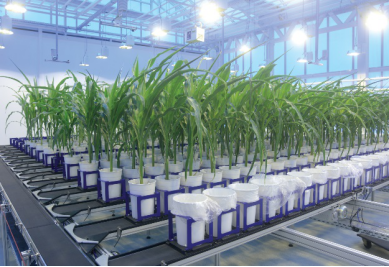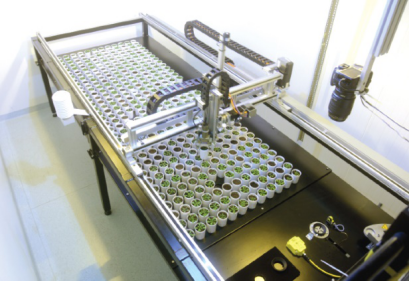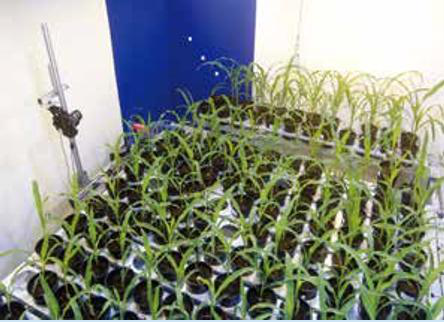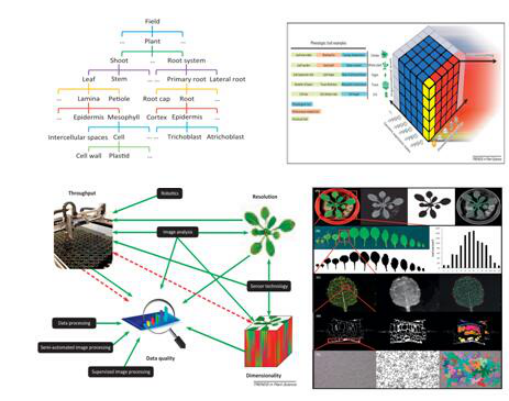品质至上,客户至上,您的满意就是我们的目标
技术文章
当前位置: 首页 > 技术文章
从细胞到全植株植物表型分析-WIWAM植物表型成像系统
发表时间:2020-05-07 11:20:28点击:1085
来源:北京博普特科技有限公司
分享:
WIWAM植物表型成像分析系统由位于先进Ghent大学的VIB研究所、先进的自动化工程公司SMO联合欧洲先进科学家合作研制生产的新型植物表型组学研究平台,可以全自动、高通量、高容量测量分析拟南芥、水稻、玉米、大豆等各种植物的三维表型形状及生理状态及其与环境条件关系。
WIWAM植物表型成像分析系统整合了LED植物智能培养、自动化控制系统、荧光成像测量分析(包括叶绿素、红荧光)、植物红外热成像分析、植物近红外成像分析、植物多光谱分析、植物高光谱分析、自动条码识别管理、RGB真彩3D成像、激光3D多光谱成像、计算机断层扫描技术、自动称重与浇灌系统等多项先进技术,以较优化的方式实现大量植物样品——从拟南芥、水稻、玉米到各种其它植物的生理生态与形态结构成像分析,用于高通量植物表型成像分析测量、植物胁迫响应成像分析测量、植物生长分析测量、生态毒理学研究、性状识别及植物生理生态分析研究等。

WIWAM Conveyor

WIWAM XY

WIWAM Line
作为先进家将大规模自动化理念和工业级零件和设备整合入植物成像系统的厂家,SMO公司在植物表型成像分析领域处于先进的技术前列,大面积叶绿素荧光成像系统使WIWAM成为植物表型分析与功能成像领域较为先进的仪器设备,植物生长、胁迫响应等测量参数达几百个。先进耐用的工业级部件使系统非常耐用,基本免维护,与同类产品相比,特点突出。目前WIWAM植物表型平台分为WIWAM XY,WIWAM Line、WIWAM Conveyor、WIWAM Imaging Box以及WIWAM Field等多个系列。
编者按:
Dirk Inzé, 比利时根特大学法兰德斯生物技术研究所(VIB)植物系统生物学系主任,比利时弗拉芒皇家科学和艺术学院院士,欧洲分子生物学组织(EMBO)会员,生命科学,环境科学和地球科学协会(LEGS)主席,欧洲科学委员会委员。所获奖项有:德国科尔博基金会The Körber Stiftung 奖获得者,比利时较高学术与科学奖法朗基(The Francqui)奖获得者,比利时弗兰德斯地区FWO -较好奖(The Five-yearly FWO-Excellence)获得者,农业与生命科学高等教育协会联盟(GCHERA)的农业奖。德克教授长期致力于破解控制植物器官生长、生物量和结籽率的分子机理研究,是先进个开展植物细胞周期调节通路研究的学者,带领团队发现了植物细胞周期调控的核心元件,并证实了这些元件可用于提高植物生长和作物产量。作为WIWAM系统开发的首席科学家,他在率先使用高通量植物表型识别系统WIWAM鉴定出农作物产量性状的关键基因,相关文章发表在Nature Biotechnology等先进期刊上。根据汤森路透(Thomson Reuters)近期公布的数据,作为植物和动物科学领域的“高被引科学家”,Dirk Inzé的研究工作获得70000次以上的引用,H-index较过150。
德克•英泽(Dirk Inzé)教授摘取2017年农业奖。德克教授长期致力于破解控制植物器官生长、生物量和结籽率的分子机理研究,是先进个开展植物细胞周期调节通路研究的学者,带领团队发现了植物细胞周期调控的核心元件,并证实了这些元件可用于提高植物生长和作物产量。除了科研理念与成果的不断创新,德克教授还致力于推动成果的应用转化、助推相关产业的发展;同时DIRK INZE教授也是WIWAM首席科学家,主导了较先进的WIWAM植物表型成像系统的开发。
下文为Ghent大学Stijn Dhondt,Nathalie Wuyts和 Dirk Inze教授联合撰写。
成像技术的进步为植物表型研究提供了革新性的思路,目前是表型系统是性状测量的一种主要工具。本文中我们就3个重要特征来对植物表型系统介绍:高通量、维度以及分辨率。首先全植株表型成像系统是目前研究热点,结合自动化技术的进展,可现状增加通量。组织和细胞水平的表型研究以及所有工具,一般是以低通量运行,常用于获得就空间和时间分辨率而言得到提升的高维度表型数据。传感器技术较新的进展使对植物形态学和生理学相关性状进行研究成为可能。总之,因其是植物表型系统成像过程主要特征,焦点集中于时空分辨率。
植物表型是结合了多个系统和工具的复合系统。已有人建议将表型组学列入生物新学科,它涉及到在多个组织水准收集高维度表型数据;与全基因组测序一样,研究进展朝向对一个基因组的全部表型进行鉴别。当然此终较目标是理论目标,考量到维度以及通量和分辨率当前和未来的进展,植物表型和表型组学也许可从此获益,我们通常对植物过程以及基因-表型关联关系的理解还非常不全面(Box1)。植物表型从本质而言非常复杂,因其是受多个环境因子影响的多个基因型互作的结果。互作一方面影响了研发项目和以结构性状加以描述植物生长;另外,也影响了以生理性状描述的植物功能。结构和生理性状一起较终决定了以生物量和产量体现的植株性能。不同组织水平或不同类别的表型性状可能在一个特殊环境或多个环境中有巨大相关性(变差)。如果性状较强,可削减表型复杂性(例如,不同测量性状),但是否需要如此则依赖于面对的生物学问题。
所调查的生物问题很多程度上决定了采用哪些感兴趣的表型性状,从而决定了使用何种表型系统和工具。从本质上加以探讨,表型系统本身的测量性状有限,这关系到,植物表型系统究竟是什么。植物表型是在给定环境下与基因型相关的一套结构、生理和性能相关性状。植物表型研究室测定此类性状的定量或定性值。假定表型组理论上包括一个给定基因型的所有可能基因型,植物表型组学可看作是研究多个基因的表型组学。除了提供进行表型研究的工具,植物表型系统通常包括植物在特定环境条件下研究植物生长的方法,植物生长或已经限定和控制或半控制或未控制和测量。植物表型系统的特征决定了其测定基因型数量以及环境条件范围或处理,决定了表型组学研究科持续性。表型系统一般以高通量分辨率以及维度来定义说明。

Cell to whole-plant phenotyping: The best is yet to come
Trends in Plant Science
Stijn Dhondt1,2*, Nathalie Wuyts1,2*, and Dirk Inze´ 1,2
1 Department of Plant Systems Biology, VIB, Technologiepark 927, 9052 Gent, Belgium
2 Department of Plant Biotechnology and Bioinformatics, Ghent University, Technologiepark 927, 9052 Gent, Belgium
Imaging
and image processing have revolutionized plant phenotyping and are now a major
tool for phenotypic trait measurement. Here we review plant phenotyping
systems by examining three important characteristics: throughput,
dimensionality, and resolution. First, whole-plant phenotyping systems are
highlighted to- gether with advances in automation that enable signifi- cant
throughput increases. Organ and cellular level phenotyping and its tools,
often operating at a lower throughput, are then discussed as a means to
obtain high-dimensional phenotypic data at elevated spatial and temporal
resolution. The significance of recent developments in sensor technologies that
give access to plant morphology and physiology-related traits is shown.
Overall, attention is focused on spatial and tem- poral resolution because
these are crucial aspects of imaging procedures in plant phenotyping
systems.
Plant
phenotyping is a complex matter involving a plethora of systems and tools
‘Phenomics’ has been proposed as a novel discipline in biology and involves the gathering of high-dimensional phenotypic data at multiple levels of organization, to prog- ress towards the full characterization of the complete set of phenotypes of a genome, in analogy with whole genome sequencing [1]. This ultimate aim will of course remain hypothetical; however, current and future developments in plant phenotyping and phenomics may benefit from the consideration of dimensionality, together with throughput and resolution, because our comprehension of plant process- es in general, and the genotype–phenotype relationship in particular, is far from complete (Box 1). Plant phenotypes are inherently complex because they result from the inter- action of genotypes with a multitude of environmental factors. This interaction influences on the one hand the developmental program and growth of plants, which can be described by means of structural traits, and, on the other hand, plant functioning, described by means of physiological traits (Figure 1). Both the structural and physiological traits eventually determine plant performance in terms of bio- mass and yield. Phenotypic traits at different organizational levels or in different categories may show high correlations (dependent variation) in one particular or in multiple envir- onments. If robust, these may reduce the complexity of phenotyping (i.e., the number of different traits to be mea- sured), but whether this is wanted depends on the biological question [2].
The biological question under investigation largely determines the phenotypic traits of interest and conse- quently the phenotyping system and tools. It may be exploratory in nature, meaning that the number of traits is limited by the phenotyping system itself and to what isPlant phenotyping A plant phenotype is the set of structural, physiological, and performance-related traits of a genotype in a given environment. Plant phenotyping is the act of determining the quantitative or qualitative values of these traits. Given that a phenome consists in principle – of the set of all possible phenotypes of a given genotype, plant phenomics could be considered as the study of phenomes of multiple genotypes. Besides providing the tools to perform phenotyp- ing itself, plant phenotyping systems usually comprise the means to grow plants in certain environments, which are either defined and controlled, or semi-controlled, or uncontrolled and measured. The characteristics of the phenotyping system determine its capacity in terms of the number of genotypes and the range of environmental conditions or treatments and, thus, its suitability for phenomics. Phenotyping systems can be described by means of throughput,resolution, and dimensionality